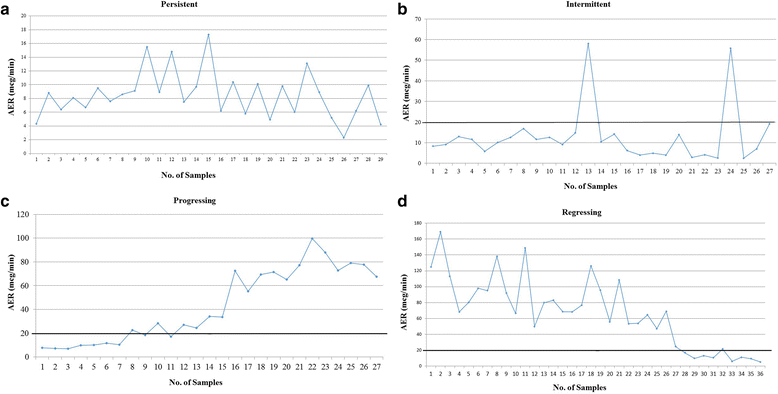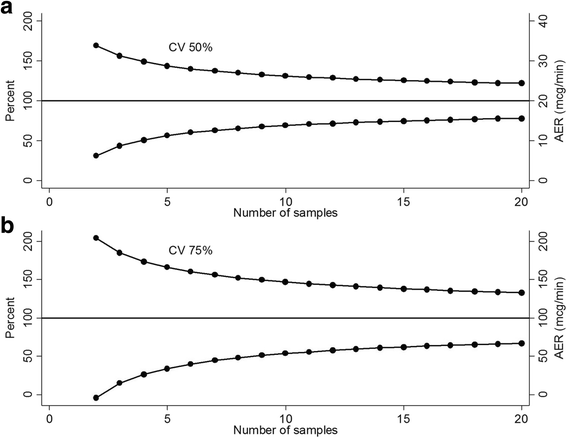Long-term intra-individual variability of albuminuria in type 2 diabetes mellitus: implications for categorization of albumin excretion rate
- PMID: 29207965
- PMCID: PMC5717840
- DOI: 10.1186/s12882-017-0767-3
Long-term intra-individual variability of albuminuria in type 2 diabetes mellitus: implications for categorization of albumin excretion rate
Abstract
Background: Diabetic kidney disease (DKD) is the leading cause of end-stage renal disease in the Western world. Early and accurate identification of DKD offers the best chance of slowing the progression of kidney disease. An important method for evaluating risk of progressive DKD is abnormal albumin excretion rate (AER). Due to the high variability in AER, most guidelines recommend the use of more than or equal to two out of three AER measurements within a 3- to 6-month period to categorise AER. There are recognised limitations of using AER as a marker of DKD because one quarter of patients with type 2 diabetes may develop kidney disease without an increase in albuminuria and spontaneous regression of albuminuria occurs frequently. Nevertheless, it is important to investigate the long-term intra-individual variability of AER in participants with type 2 diabetes.
Methods: Consecutive AER measurements (median 19 per subject) were performed in 497 participants with type 2 diabetes from 1999 to 2012 (mean follow-up 7.9 ± 3 years). Baseline clinical characteristics were collected to determine associations with AER variability. Participants were categorised as having normo-, micro- or macroalbuminuria according to their initial three AER measurements. Participants were then categorised into four patterns of AER trajectories: persistent, intermittent, progressing and regressing. Coefficients of variation were used to measure intra-individual AER variability.
Results: The median coefficient of variation of AER was 53.3%, 76.0% and 67.0% for subjects with normo-, micro- or macroalbuminuria at baseline. The coefficient of variation of AER was 37.7%, 66% and 94.8% for subjects with persistent, intermittent and progressing normoalbuminuria; 43%, 70.6%, 86.1% and 82.3% for subjects with persistent, intermittent, progressing and regressing microalbuminuria; and 55.2%, 67% and 82.4% for subjects with persistent, intermittent and regressing macroalbuminuria, respectively.
Conclusion: High long-term variability of AER suggests that two out of three AER measurements may not always be adequate for the optimal categorisation and prediction of AER.
Keywords: Albumin excretion rate; Chronic kidney disease; Diabetes; Diabetes mellitus type 2; Diabetic nephropathy; End-stage kidney disease; Microalbuminuria; Urinary excretion rate.
Conflict of interest statement
Ethics approval and consent to participate
The study was approved by the Human Research Ethics Committee at Austin Health and patients provided written informed consent.
Consent for publication
Not applicable.
Competing interests
The authors declare that they have no competing interests.
Publisher’s Note
Springer Nature remains neutral with regard to jurisdictional claims in published maps and institutional affiliations.
Figures


Similar articles
-
Early urinary markers of diabetic kidney disease: a nested case-control study from the Diabetes Control and Complications Trial (DCCT).Am J Kidney Dis. 2010 May;55(5):824-34. doi: 10.1053/j.ajkd.2009.11.009. Am J Kidney Dis. 2010. PMID: 20138413 Free PMC article.
-
Albuminuria Changes and Cardiovascular and Renal Outcomes in Type 1 Diabetes: The DCCT/EDIC Study.Clin J Am Soc Nephrol. 2016 Nov 7;11(11):1969-1977. doi: 10.2215/CJN.02870316. Epub 2016 Oct 24. Clin J Am Soc Nephrol. 2016. PMID: 27797889 Free PMC article.
-
Albumin excretion rate and its relation to kidney disease in non-insulin-dependent diabetes mellitus.J Intern Med. 1995 Apr;237(4):367-73. doi: 10.1111/j.1365-2796.1995.tb01188.x. J Intern Med. 1995. PMID: 7714459 Clinical Trial.
-
Diabetic kidney disease with and without albuminuria.Curr Opin Nephrol Hypertens. 2011 May;20(3):246-57. doi: 10.1097/MNH.0b013e3283456546. Curr Opin Nephrol Hypertens. 2011. PMID: 21422923 Review.
-
Normoalbuminuric diabetic kidney disease.Front Med. 2017 Sep;11(3):310-318. doi: 10.1007/s11684-017-0542-7. Epub 2017 Jul 18. Front Med. 2017. PMID: 28721497 Review.
Cited by
-
High-Throughput Metabolomics and Diabetic Kidney Disease Progression: Evidence from the Chronic Renal Insufficiency (CRIC) Study.Am J Nephrol. 2022;53(2-3):215-225. doi: 10.1159/000521940. Epub 2022 Feb 23. Am J Nephrol. 2022. PMID: 35196658 Free PMC article.
-
Assessment and Risk Prediction of Chronic Kidney Disease and Kidney Fibrosis Using Non-Invasive Biomarkers.Int J Mol Sci. 2024 Mar 26;25(7):3678. doi: 10.3390/ijms25073678. Int J Mol Sci. 2024. PMID: 38612488 Free PMC article. Review.
-
Combination Therapy of RAS Inhibition and SGLT2 Inhibitors Decreases Levels of Endotrophin in Persons with Type 2 Diabetes.Biomedicines. 2023 Nov 17;11(11):3084. doi: 10.3390/biomedicines11113084. Biomedicines. 2023. PMID: 38002084 Free PMC article.
-
The early natural history of albuminuria in young adults with youth-onset type 1 and type 2 diabetes.J Diabetes Complications. 2018 Dec;32(12):1160-1168. doi: 10.1016/j.jdiacomp.2018.09.018. Epub 2018 Oct 4. J Diabetes Complications. 2018. PMID: 30316542 Free PMC article.
-
Clinical Features and Implications of Albuminuria Trajectories in Type 2 Diabetes: The Fremantle Diabetes Study Phase 2.J Endocr Soc. 2025 Apr 8;9(6):bvaf062. doi: 10.1210/jendso/bvaf062. eCollection 2025 Jun. J Endocr Soc. 2025. PMID: 40303548 Free PMC article.
References
-
- Foundation, N.K KDOQI clinical practice guidelines for chronic kidney disease: evaluation, classification and stratification. Am J Kidney Dis. 2002;39:S1–S266. - PubMed
-
- Chadban S, Howell M, Twigg S, Thomas M, Jerums G, Cass A, Campbell D, Nicholls K, Tong A, Mangos G, Stack A, RJ MI, Girgis S, Colagiuri R, Colagiuri S, Craig J, CARI The CARI guidelines. Assessment of kidney function in type 2 diabetes. Nephrology. 2010;15:S146–S161. doi: 10.1111/j.1440-1797.2010.01239.x. - DOI - PubMed
MeSH terms
LinkOut - more resources
Full Text Sources
Other Literature Sources
Medical

